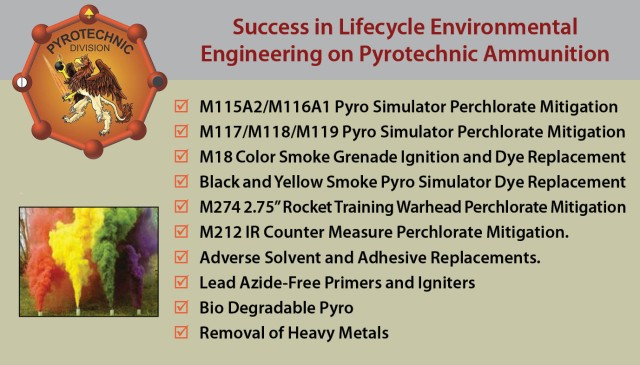When three Picatinny pyrotechnic scientists were assigned to develop a more environmentally friendly formula for a flare that emits green light, they stumbled upon a breakthrough: a cheap ceramic compound long considered inert and never even considered for pyrotechnics.
If development of the boron-carbide technology continues to unfold successfully, it would lessen the environmental and financial impacts of green-light military flares for the Army. Based on their research, that's the conclusion by scientists Jesse J. Sabatini, Jay C. Poret and Russell N. Broad of the U.S. Army Armament Research, Development and Engineering Center (ARDEC).
An article published in the April issue of the journal Nature emphasized that boron carbide's widespread availability may also entice fireworks companies and theme parks that seek "greener pastures" through environmentally "green" technology to adopt the use of boron carbide compounds.
For decades, both the Army and private industry have used barium compounds to generate green light for pyrotechnics, yet barium is a toxic-heavy metal.
Furthermore, to mix a barium compound to generate the desired green glow, it must be combined with chlorinated compounds that, when burned, can produce toxic polychlorinated biphenyl, better known by the acronym PCB.
An Environmental Protection Agency fact sheet says PCBs probably cause cancer in humans and are known to cause a variety of serious health effects.
In view of the environmental threats, the U.S. Army undertook an effort to remove hazardous compounds from military pyrotechnics, said Poret. He, Sabatini and Broad began exploring alternative compounds in 2009 that would emit green light.
They also considered some exotic copper-based compounds to flare the desired color. However, the compounds were fickle in terms of color and expensive to make.
Other copper-based compounds were too sensitive to both impact and external stimuli to be useful for military purposes, according to a peer-reviewed research paper published this spring in the journal, Angewandte Chemie, International Edition.
They also looked into mixes with amorphous boron and potassium nitrate, only to find that while they flared the brightest green, the duration was too short. Soldiers need a longer-burning flare that can illuminate night-time maneuvers, signal for aircraft or call for help.
Then they considered boron carbide.
"Why would you use boron carbide'" Poret said of the prevailing attitude among chemists toward the substance. "Are you nuts'"
Registering 9.3 on a scale of hardness where diamonds are a 10, boron carbide's uses were limited to making items such as armor and abrasives.
It's not water soluble. It had never even been considered for pyrotechnics, and their formulations reacted stubbornly to external stimuli -resisting friction, impact and electrostatic discharge, according to Sabatini.
"It had been written off as a compound that really didn't do anything," he said.
After experimenting in the laboratory and performing modeling and simulation studies, Poret said the team "stumbled across" boron carbide while reviewing classic scientific literature from the 1950s and 1960s.
According to the literature, which listed the chemical and physical properties of boron carbide, the team believed that the chemical might work if it was in a powder form, then combined with a suitable oxidizer.
"We had that day in the lab," said Poret. "It worked great. It generated green light."
"It was a great time for both of us, just because it had never been done," Sabatini added.
They conducted other experiments on boron-based formulations and verified that its gaseous emissions were not considered as hazardous.
They also performed modeling work to analyze for the potential of hazardous release into ground water.
But they believe boron carbide's inertness translates into no hazard to humans and the environment.
Yet hard work remains. To develop a compound to replace the one used in the M125A1 Hand-held Signal Flare, the team must "scale up" from the smaller quantities of the experimental formulations to the larger quantities used in the field.
As development continues, the scientists will continue to optimize the pyrotechnic mixture of binders, oxidants and adjust the grain sizes of boron carbide powders. Sabatini and Poret are optimistic they will succeed.
Their initial goal is to develop a new formulation for the M125A1, which is used in combat and in training ranges in the U.S. and overseas.
The M125A1 is carried by Soldiers in their rucksacks. When needed, the Soldier points it skyward and strikes the bottom on a hard surface, shooting the flare upward several hundred feet and emitting a bright green light.
Other possible uses of the boron carbide technology for green light emission include 40mm cartridges launched by grenade launcher, the M195 parachute hand-held signal flare, as well as civilian and commercial fireworks.
"What I hear all too frequently in energetics research is that we're done making breakthroughs," said Sabatini. "That's why these barium based formulations have been around for decades."
Which reminded Sabatini of one of his favorite sayings: "A 21st century problem requires a 21st century solution."




Social Sharing